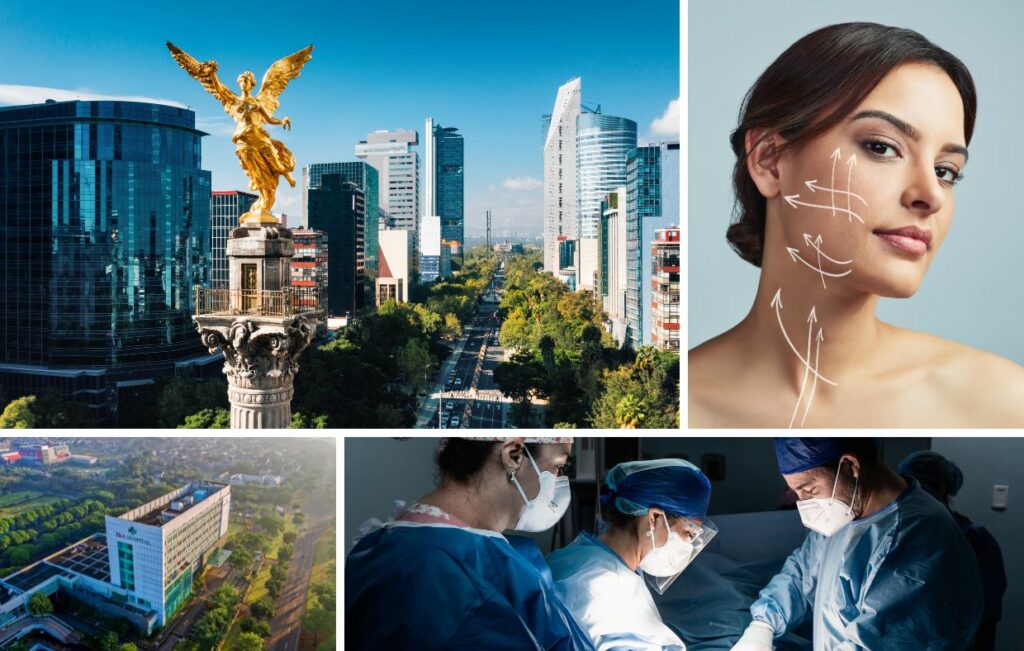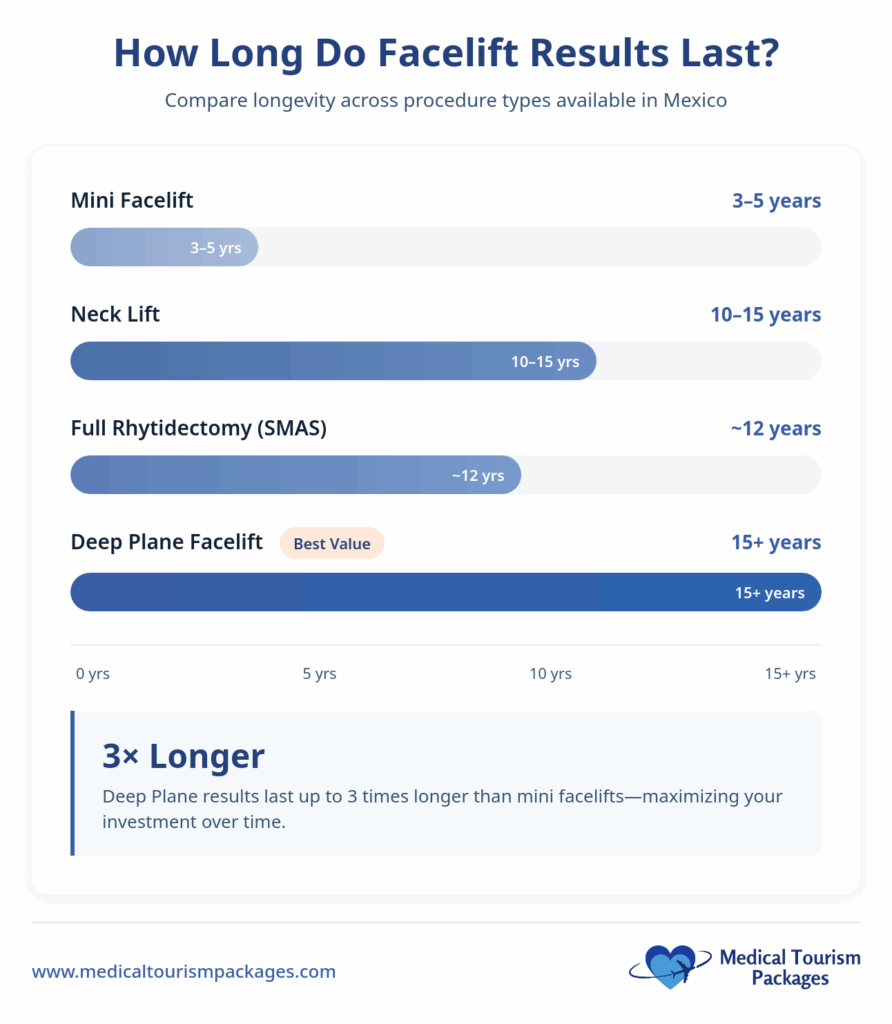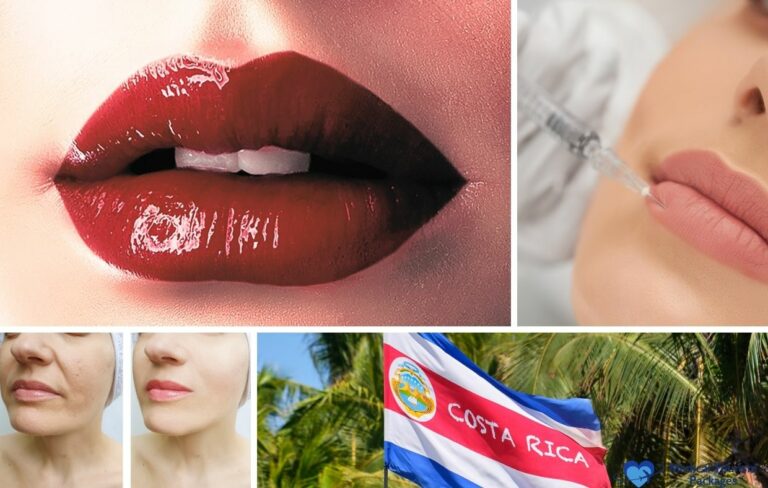Book Appointment Now

Rhytidectomy Surgery in Mexico: Cost, Safety, and Complete Guide for Medical Tourists
Get a facelift in Mexico for $3,000 to $12,000. This is 50-75% less than US prices. Board-certified surgeons in Tijuana, Cancun, Guadalajara, Mexico City, and Monterrey perform facelifts at JCI-accredited facilities. You receive the same quality care as top US hospitals at a fraction of the cost.
A rhytidectomy removes excess facial skin and tightens underlying tissues. The surgery reduces sagging, wrinkles, and jowls. It restores a firmer, smoother facial contour. Mexican surgeons offer everything from mini facelifts to advanced Deep Plane procedures.
This guide covers costs, safety standards, surgeon credentials, and recovery timelines. You’ll learn how to choose a qualified facility and plan your medical tourism journey.
What Is Rhytidectomy Surgery?
Rhytidectomy is the medical term for a facelift. The surgery addresses visible signs of facial aging. Your surgeon removes excess skin and tightens underlying muscles. Then they re-drape the skin on your face and neck. The result is a firmer, smoother facial contour.
Mexican surgeons offer several facelift techniques. Each targets different aging concerns. Your surgeon will recommend the best option based on your age and skin condition.
What Types of Facelift Procedures Are Available in Mexico?
Four main facelift procedures are available in Mexico: mini facelift, full SMAS rhytidectomy, Deep Plane facelift, and neck lift. Each offers different levels of correction and longevity.
| Procedure Type | What It Does | Recovery Time | Results Duration |
|---|---|---|---|
| Mini Facelift | Addresses mild to moderate sagging in the lower face and neck using shorter incisions | 1-2 weeks | 3-5 years |
| Full Rhytidectomy (SMAS) | Separates skin from underlying muscle, tightens the SMAS layer, then re-drapes the skin | 2-3 weeks | ~12 years |
| Deep Plane Facelift | Lifts skin, fat pads, and SMAS muscle as one composite flap for deeper repositioning | 3-4 weeks | 15+ years |
| Neck Lift | Tightens sagging skin and muscles in the neck area; can be combined with facelift | 2-3 weeks | 10-15 years |

The Deep Plane technique requires advanced surgical expertise. Surgeons operate in a deeper anatomical plane. They must understand facial nerve anatomy thoroughly. This approach offers superior, longer-lasting results. Mexico is a trusted destination for this specialized procedure.
How Much Does Rhytidectomy Surgery Cost in Mexico?
Facelift surgery in Mexico costs much less than in the US or Canada. You can save 50% to 75% on your procedure. These savings remain significant even after travel expenses.
The price varies based on the facelift type you choose. Your surgeon’s experience affects the cost. The city where you have surgery also matters. Complex techniques like Deep Plane cost more but still beat US pricing.
How Do Mexico Facelift Costs Compare to the US and Canada?
Mexico costs 50-75% less than the US and Canada across all procedure types. The table below shows exact price ranges for each facelift option.
| Procedure Type | Mexico Cost Range | US Cost Range | Canada Cost Range | Savings vs. US |
|---|---|---|---|---|
| Mini Facelift | $3,000 – $6,000 | $7,000 – $15,000 | $8,000 – $15,000 | 50-75% |
| Full Rhytidectomy (SMAS) | $4,500 – $9,000 | $12,000 – $25,000+ | $10,000 – $20,000+ | 50-70% |
| Deep Plane Facelift | $7,000 – $12,000 | $20,000 – $35,000 | $18,000 – $30,000 | 50-65% |
| Neck Lift | $2,500 – $5,000 | $6,000 – $12,000 | $6,000 – $12,000 | 50-60% |
These cost differences reflect lower operating costs in Mexico. Medical liability insurance is cheaper there. The lower prices do not mean lower quality at accredited clinics. Mexican surgeons at JCI-accredited facilities deliver outcomes matching top US practices.
Is Rhytidectomy Surgery Safe in Mexico?
Facelift surgery in Mexico is safe at accredited facilities with board-certified surgeons. A study of over 7,000 cosmetic procedures found a 6.2% complication rate per patient. This compares favorably with US plastic surgery benchmarks.
High-volume, internationally accredited centers achieve excellent safety outcomes. Specific complication rates per patient include:
- Hematoma: 1.30%
- Surgical site infection: 1.50%
- Deep Vein Thrombosis (DVT): 0.20%
- Pulmonary Embolism (PE): 0.10%
Mexico’s medical tourism market has two quality levels. Top-tier facilities deliver world-class care. An unregulated sector poses serious health risks. Accreditation separates safe care from dangerous facilities. Your safety depends on choosing an accredited clinic. Read our comprehensive guide for medical tourists in Mexico for more details on choosing safe facilities.
What Certifications Should Your Surgeon Have?
Your surgeon should have CME/CMCPER board certification at minimum. ISAPS membership indicates additional commitment to international standards.
- Mexican Board of Plastic, Aesthetic, and Reconstructive Surgery (CME/CMCPER): This is the core certification for plastic surgeons in Mexico. Surgeons must complete a medical degree, four-year general surgery residency, and three-year plastic surgery specialization.
- International Society of Aesthetic Plastic Surgery (ISAPS): Leading surgeons maintain ISAPS membership. This signals adherence to international safety standards and continued education.
What Facility Accreditations Should You Look For?
You should look for JCI accreditation, COFEPRIS certification, and evidence of sterile environment standards. These accreditations ensure your facility meets international safety protocols.
- Joint Commission International (JCI): JCI ensures facilities follow strict safety protocols. They maintain hygiene standards and emergency response systems comparable to top US hospitals.
- COFEPRIS: Mexico’s health regulatory body confirms facilities meet government safety standards.
- Sterile Environment Standards: Accredited clinics have sterile surgical rooms and advanced air filtration. They use comprehensive sterilization procedures for all equipment.
Which Mexican Cities Offer the Best Rhytidectomy Facilities?
Mexico has several cities with high-quality plastic surgery facilities. Each destination offers unique advantages. Your choice depends on travel convenience, budget, and recovery preferences.
Which Mexican Cities Have the Best Facelift Clinics?
The best facelift clinics are in Tijuana, Cancun, Guadalajara, Mexico City, and Monterrey. Each city offers unique advantages depending on your location and preferences.
| City | Key Features | Best For |
|---|---|---|
| Tijuana | Highly accessible from Southern California; short drive from San Diego border; facilities include Hospital Angeles Tijuana | Patients wanting minimal travel time from US West Coast |
| Cancun | Beach resort recovery environment; international airport with direct US flights | Patients wanting leisure recovery in a tropical setting |
| Guadalajara | Major medical hub with renowned specialists; strong medical infrastructure | Patients seeking established surgical expertise |
| Mexico City | Largest concentration of board-certified specialists; premier facilities | Patients wanting the widest selection of top surgeons |
| Monterrey | San Pedro Garza Garcia district has upscale, high-security facilities | Patients prioritizing luxury accommodations and security |
All five cities have JCI-accredited facilities. They have surgeons certified by the Mexican Board. Your choice depends on your US location and recovery preferences.
How Do You Choose a Qualified Rhytidectomy Surgeon in Mexico?
Choosing the right surgeon is your most important decision. Rigorous credential verification is essential. The surgical facility quality matters as much as surgeon expertise.
How Do You Verify a Surgeon’s Credentials?
You verify credentials by checking board certification, confirming international memberships, and reviewing patient outcomes. Follow these five steps to ensure your surgeon is qualified.
- Validate CME/CMCPER certification. This is the core certification for Mexican plastic surgeons. Request proof and verify the certificate is current.
- Confirm ISAPS membership. The International Society of Aesthetic Plastic Surgery has strict membership standards.
- Verify through official medical boards. Cross-check certification through the official CME/CMCPER registry.
- Seek patient testimonials. Use verified platforms like RealSelf or Google Reviews. Look for patients who had similar procedures.
- Review before-and-after photos. Quality clinics provide extensive photo documentation. Look for consistent results across various patient types. Be skeptical of clinics with only dramatic, edited images.
What Should Medical Tourists Expect During Rhytidectomy Recovery in Mexico?
Recovery requires careful planning and patience. You’ll spend 1-2 nights in the hospital under medical supervision. Then recovery continues at a designated accommodation.
The first week is most intensive. You’ll experience swelling, bruising, and discomfort. Your surgeon prescribes medications to manage these. Board-certified surgeons require 7-14 days in Mexico minimum. This allows initial healing and essential follow-up appointments.
Do not travel home too soon. Flying early raises your risk of Deep Vein Thrombosis and Pulmonary Embolism. Both conditions can be life-threatening. Air travel increases these risks due to cabin pressure and immobility.
What Is the Complete Recovery Timeline?
The complete recovery timeline spans from surgery day to 6-12 months for final results. You’ll need 10-14 days in Mexico before flying home safely.
| Timeframe | What to Expect | Key Milestones |
|---|---|---|
| Days 1-2 | Hospital stay with medical monitoring; pain management; limited mobility | Initial wound care; drains placed if needed |
| Days 3-14 | In-country recovery with daily nurse visits for vital checks and dressing changes | Suture or drain removal; surgeon follow-up; travel clearance |
| Weeks 2-3 | Bruising and swelling begin to subside; gradual return to light activities | Most visible surgery signs diminish; safe to return home |
| Months 1-3 | Continued swelling reduction; increased activity level | Resume normal daily activities; final incision healing |
| Months 6-12 | Final results become fully visible as tissues settle | Complete assessment of surgical outcome |
Plan for the full 10-14 day stay in Mexico. This recovery period is essential for your safety.
What Are the Steps to Planning Rhytidectomy Surgery in Mexico?
Planning requires careful preparation. Mexican clinics typically schedule procedures within 2-4 weeks. This is much faster than Canada or the US. Learn more about our facelift coordination services to simplify your planning.
What Are the Steps to Plan Your Surgery?
You plan your surgery by researching facilities, scheduling consultations, and preparing for travel. Follow these eight steps from initial research to post-operative recovery.
- Research accredited surgeons and facilities. Verify CME/CMCPER certification. Check for JCI accreditation. Review before-and-after photos and patient testimonials.
- Schedule your consultation. Contact your chosen clinic for an in-person or video consultation. Discuss your goals, medical history, and recommended technique.
- Confirm surgery date and book travel. Plan to stay in Mexico for 10-14 days minimum.
- Prepare travel documents. US citizens need a valid passport or trusted traveler card. Most visitors don’t need visas but must follow tourist card rules.
- Arrive 1-3 days before surgery. This allows time for consultations and lab tests.
- Complete pre-operative assessments. Your surgeon conducts final examination and reviews lab results.
- Undergo your procedure. Surgery takes place at the accredited facility with a certified anesthesiologist.
- Begin your recovery. Spend 1-2 nights in hospital. Then move to recovery accommodation for remaining days.
The entire process from consultation to flying home takes 3-4 weeks. Build flexibility into your schedule.
What Are the Advantages of Getting Rhytidectomy Surgery in Mexico?
Mexico offers compelling advantages for facelift patients. Benefits extend beyond cost savings.
What Are the Main Advantages?
The main advantages are significant cost savings, access to skilled surgeons, advanced facilities, and safety outcomes matching North American standards.
- Save 50-75% compared to North America. You can save tens of thousands of dollars. Savings remain significant even after travel costs.
- Access highly trained surgeons. Many Mexican plastic surgeons trained at prestigious US or European institutions.
- Use advanced surgical facilities. Mexican facilities have cutting-edge technology matching top international centers.
- Get Deep Plane expertise at competitive prices. Mexico is recognized for advanced Deep Plane techniques. Many accredited surgeons specialize in this procedure.
- Receive comparable quality and safety. Accredited, high-volume centers achieve safety metrics matching North American practices.
What Are the Risks of Rhytidectomy Surgery in Mexico?
Medical tourists face specific risks requiring careful consideration. Understanding these helps you make informed decisions.
What Are the Key Risks to Consider?
The key risks include facility quality variation, travel-related blood clots, complication management challenges, and incomplete medical documentation.
- Mexico’s dual medical market requires careful facility selection. Quality ranges from JCI-accredited excellence to dangerous facilities. Pre-selection is your most vital safety measure.
- Air travel increases blood clot risks. Flying too soon after surgery raises DVT and PE risk. This is why surgeons mandate 7-14 day in-country recovery.
- Complication management at home presents challenges. A survey found 80.4% of US plastic surgeons treated patients with medical tourism complications. Your home doctor may face difficulties without complete records.
- Treating complications domestically can be expensive. Managing complications costs $6,000 to $26,000. Severe complications can negate your original savings.
- Incomplete documentation creates care problems. Get complete operative notes before leaving Mexico. These should detail the surgical technique, medications, and complications.
Who Is a Good Candidate for Rhytidectomy Surgery in Mexico?
Not everyone is suitable for facelift surgery. Your surgeon evaluates your health, skin condition, and goals.
What Makes Someone an Ideal Candidate?
An ideal candidate is a healthy non-smoker in their 40s-60s with visible aging signs and realistic expectations about surgical outcomes.
- Good overall health with no healing impairments. You must be stable and healthy. You should tolerate general anesthesia and surgical stress.
- Non-smoker or willing to quit. Smoking impairs wound healing significantly. Quit 4-6 weeks before surgery and throughout recovery.
- Visible aging signs that non-surgical treatments can’t correct. Good candidates show deep facial creases, pronounced jowls, and significant skin laxity.
- Age typically in 40s to 60s. Most patients are middle-aged adults. However, skin quality matters more than age.
- Younger patients (40s-50s) may benefit most from Deep Plane technique. This procedure offers structural changes lasting 15+ years. Extended longevity makes it cost-effective over your lifetime.
- Realistic expectations about outcomes. Understand what surgery can and cannot achieve. Pursue surgery for yourself, not others’ expectations.
Is Rhytidectomy Surgery in Mexico Worth It for Medical Tourists?
Mexico combines substantial cost savings with highly trained surgeons. For the right patient who takes proper precautions, the answer is yes.
Accredited, high-volume centers deliver quality and safety matching North American practices. Studies confirm complication rates at top Mexican facilities meet US benchmarks.
However, success depends on minimizing cross-border care risks. Mexico’s dual medical market requires careful pre-selection. You cannot rely on post-surgical remedies if problems occur. Prevention through careful vetting is your best protection.
The Deep Plane technique benefits younger patients seeking long-term results. With results lasting 15+ years, you maximize your investment value.
Rhytidectomy surgery in Mexico is worth it if you:
- Select a JCI-accredited facility with CME/CMCPER-certified surgeons
- Verify credentials through official boards and patient reviews
- Commit to the full 10-14 day in-country recovery
- Secure complete medical documentation before returning home
- Have realistic expectations and understand the risks
Approach medical tourism with diligence and thorough research. Mexico provides an excellent opportunity to achieve your aesthetic goals with significant savings.
Frequently Asked Questions About Rhytidectomy in Mexico
How Long Do Facelift Results Last?
Results depend on the technique you choose. A mini facelift lasts 3–5 years. A full SMAS facelift lasts about 12 years. A Deep Plane facelift can last 15+ years.
Is It Safe to Fly Home After Surgery?
You must wait 7–14 days before flying. Traveling too soon raises your risk of blood clots. Your surgeon will clear you for travel at your follow-up appointment.
What If I Have Complications After Returning Home?
Get complete medical records before leaving Mexico. Find a local plastic surgeon willing to provide follow-up care. Consider medical tourism insurance that covers complications.
Do I Need a Visa to Get Surgery in Mexico?
US citizens only need a valid passport. Most visitors do not need a visa for medical tourism stays under 180 days.
How Long Should I Stay in Mexico After a Facelift?
Plan to stay 10–14 days to attend early follow-ups and allow initial swelling to settle. If you combine procedures or need drains, budget up to 2–3 weeks. Your surgeon will provide the final clearance to travel.
What Pre-Op Tests or Records Should I Bring?
Bring a valid passport, your medical history, a list of medications and allergies, recent labs or imaging if requested, and contact details for your primary care doctor. If you have chronic conditions, obtain a pre-op clearance letter.
How Do I Choose a Qualified Plastic Surgeon in Mexico?
Verify board certification, confirm the facility is accredited, review before-and-after photos of facelift cases, ask about experience with SMAS and Deep Plane techniques, check anesthesia team credentials, and request written, itemized pricing and a clear complication policy.
What Recovery Restrictions Should I Expect After a Facelift?
Sleep with your head elevated, use cold compresses as directed, avoid nicotine and alcohol, limit salt, and keep incisions clean and dry. Avoid heavy lifting and strenuous exercise for about 3–4 weeks or until cleared by your surgeon.
Should I Buy Medical Tourism Insurance?
It’s recommended. Specialized policies can help cover unexpected complications, reoperations, hospital stays, and trip changes. Confirm that elective cosmetic surgery in Mexico is covered, review exclusions, and learn the steps to file a claim before you travel.
Ready to Start Your Facelift Journey?
Medical Tourism Packages coordinates your entire rhytidectomy journey in Mexico. We connect you with board-certified plastic surgeons in Tijuana, Cancun, Guadalajara, Mexico City, and Monterrey. We arrange your travel and accommodations. We provide bilingual support throughout your treatment. Get a free consultation to discuss your aesthetic goals and receive a personalized quote.
Contact us today to start planning your affordable facelift in Mexico.



